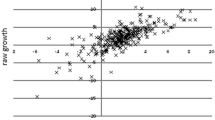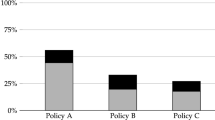Abstract
Using aggregate time series analysis, this empirical study extends the Copeland and Laband [2002] analysis of expressive voting. After allowing for economic considerations in the form of tax rates and inflation, it is found that even the aggregate voter participation rate may reflect emotional voting behavior. The Vietnam War, Watergate, public dissatisfaction with government, and the opportunity to participate in Presidential elections, each of which can be viewed at some level as an issue evoking emotional responses rather than mere cost-benefit computations, all prove to significantly affect voter participation rates.
Similar content being viewed by others
References
Aldrich, J. H.; Simon, D. M. “Turnout in American National Elections,” In S. Long (Ed.),Research in Micropolitics, 1, Greenwich, Connecticut: JAI Press, 1986.
Ashenfelter, O.; Kelley, S., Jr. “Determinants of Participation in Presidential Elections,”Journal of Law and Economics 18, 1975, pp. 695–733.
Brazel, Y.; Silberberg, E. “Is the Act of Voting Rational?”Public Choice, 16, 1973, pp. 51–8.
Buchanan, J. M.; Tullock, G.The Calculus of Consent, Ann Arbor, MI: University of Michigan Press, 1962.
Cebula, R. J. “The Electoral College and Voter Participation: Evidence on Two Hypotheses Using Results from the 1996 Presidential Election,”Atlantic Economic Journal, 30, 2001, pp. 67–75.
Council of Economic Advisors.Economic Report of the President, Washington, D.C.: U.S. Government Printing Office, 1999.
——.Economic Report of the President, Washington, D.C.: U.S. Government Printing Office, 2002.
Cox, G. W.; Munger, M. C. “Closeness, Expenditures, and Turnout in 1982 U.S. House Elections,”American Political Science Review, 83, 1989, pp. 217–31.
Downs, A.An Economic Theory of Democracy, New York: Harper and Row, 1957.
Green, D. P.; Shapiro, I.Pathologies of Rational Choice Theory: A Critique of Applications in Political Science, New Haven: Yale University Press, 1994.
Greene, K. V.; Nikolaev, O. “Voter Participation and the Redistributive State,”Public Choice, 98, 1999, pp. 213–26.
IDEA: “Voter Turnout from 1945–97,” 1999, www.IDEA.int/turnout/northamerica/usa.html.
Lapp, M. “Incorporating Groups into Rational Choice Explanations of Turnout: An Empirical Test,”Public Choice, 98, 1999, pp. 171–85.
Riker, W. H.; Ordeshook, P. C. “A Theory to the Calculus of Voting,”American Political Science Review, 62, 1973, pp. 25–43.
Schwartz, T. “Your Vote Counts on Account of the Way It is Counted: An Institutional Solution to the Paradox of Voting,”Public Choice, 54, 1987, pp. 101–21.
Tiebout, C. M. “A Pure Theory of Public Expenditures,”Journal of Political Economy, 64, 1956, pp. 416–24.
Tullock, G. “Public Decisions as Public Goods,”Journal of Political Economy, 79, 1971, pp. 913–18.
White, H. “A Heteroskedasticity-Consistent Covariance Matrix Estimator and a Direct Test for Heteroskedasticity,”Econometrica, 48, 1980, pp. 817–38.
Author information
Authors and Affiliations
Rights and permissions
About this article
Cite this article
Cebula, R.J. Expressiveness and voting: Alternative evidence. Atlantic Economic Journal 32, 216–221 (2004). https://doi.org/10.1007/BF02299439
Issue Date:
DOI: https://doi.org/10.1007/BF02299439




